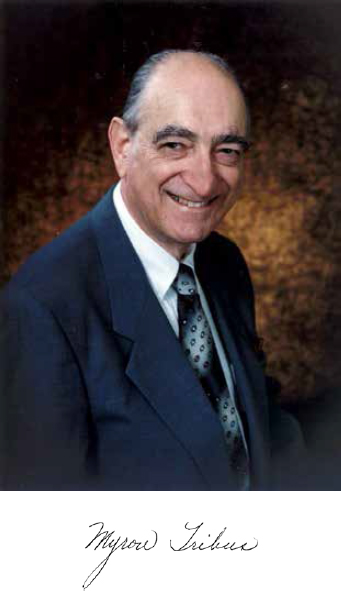This page intentionally left blank.

MYRON TRIBUS
1921–2016
Elected in 1973
“Contributions to applied sciences that support engineering, to engineering education, and for professional service in education, government, and industry.”
BY MEG MURPHY AND DONNA SAVICKI
SUBMITTED BY THE NAE HOME SECRETARY
MYRON TRIBUS, an American organizational theorist and former director of the Center for Advanced Engineering Study at the Massachusetts Institute of Technology, died August 31, 2016, at the age of 94. He was cofounder of Exergy Inc., a company specializing in the design of advanced, high-efficiency power production systems.
Myron was born in San Francisco on October 30, 1921. He graduated from the University of California, Berkeley, in 1942 with a BS in chemistry and received his PhD in engineering from the University of California, Los Angeles, in 1949.
During World War II he was a captain in the US Air Force and worked as a design-development officer at Wright Field. After the war he joined General Electric and became a gas turbine design engineer, but decided to go back into academia and joined the faculty of UCLA, where he taught thermodynamics, fluid mechanics, and heat transfer. He was a visiting professor and director of research at the University of Michigan in 1951–53.
In 1961 he was named dean of Dartmouth College’s Thayer School of Engineering, where he introduced the unified
__________________
Tributes by John Collier and Elsa Garmire are posted in Dartmouth Engineer Magazine, available at https://engineering.dartmouth.edu/magazine/tribute-myron-tribus.
engineering curriculum and led faculty in developing a new curriculum based on engineering design and entrepreneurship. He focused on “breadth, then depth”—students studied the principles underlying all areas of engineering before pursuing particular fields. He emphasized real-life experience in creative applications of engineering and believed hands-on engineering design is essential at all levels of the curriculum, saying, “Knowledge without know-how is sterile.”
In 1969 he accepted a post in the Nixon administration as assistant secretary of commerce for science and technology. He left the Department of Commerce after 18 months, in November 1970, to become senior vice president for research and engineering at Xerox Corporation.
In 1975 he joined the MIT School of Engineering faculty as full professor and director of the Center for Advanced Engineering Study (CAES). Created in 1963, the center was a major effort by MIT to give working engineers and scientists in industry and government opportunities to refresh and enrich their engineering knowledge on a continuing basis.
As director, Myron enlarged and broadened CAES’s activities. When he arrived, the center’s Advanced Study Program (ASP), which brings practicing engineers and scientists to the MIT campus, had non-US enrollment of 75 percent. Myron was charged with increasing US participation and by 1985–86, his last year as CAES director, US enrollment in the ASP was up to 48 percent.
Under Myron’s leadership, the center’s Self-Study Video Tape Program, whose packages were used by 1,310 students worldwide in 1975, became the Video Course Program, which by 1986 offered a library of 1,000 tapes spanning 50 courses and engaging 30,000 students worldwide in distance learning. Building on Myron’s legacy, CAES, now called MIT Professional Education, offers online and in-classroom courses to more than 10,000 professionals in over 120 countries.
Myron’s research interests ranged from academic subjects such as heat transfer, fluid mechanics, probability theory, statistical interference, and thermodynamics to applied topics such as seawater demineralization, aircraft heating, aircraft ice
prevention, and the design of engineering curricula. His work influenced the domains of industrial quality, ergonomics, and education.
He also published and lectured extensively on topics of social interest, such as the position of engineers in politics, the decline of US competitiveness in world trade, the role of decision theory in political decision making, and the role of technology in society. In later years, he focused on the theory of structural cognitive modifiability of Reuven Feuerstein.
He was best known for inventing deicing systems for airplanes, work in thermodynamics, popularizing the Bayesian methods, and coining in 1962 the term “thermoeconomics.” Also of note were his studies in probability statistics and decision-making theory. Later in life, he was a leading supporter of Edward W. Deming and an interpreter of quality management and business theory.
He served on the National Advisory Committee for Aeronautics (NASA’s precursor), NATO Materials Advisory Board, US Department of Commerce Technical Advisory Board, National Advisory Committee on Oceans and Atmospheres, and board of governors for the Technion–Israel Institute of Technology.
His works included Thermostatistics and Thermodynamics: An Introduction to Energy, Information, and States of Matter, with Engineering Applications (D. Van Nostrand Co., 1961), the first textbook that bases the laws of thermodynamics on information theory rather than on the classical arguments; and Rational Descriptions, Decisions, and Designs (Pergamon Press, 1969), which introduces Bayesian decision methods into the engineering design process.
He received many honors during his lifetime. In addition to his election to the NAE in 1973, he was selected for the Thurman Bane Award (1945), given by the Institute of Aeronautical Sciences to an officer or civilian of the USAF Air Research and Development Command for an outstanding achievement in aeronautical development; the Society of Automotive Engineers Wright Brothers Medal (1945); and the ASCE Alfred Noble Prize (1952) as a joint award from seven societies for his
work developing a thermal ice protection system for aircraft. He was UCLA’s 1971–72 Engineering Alumnus of the Year and in 1998 received the American Statistical Association’s Deming Lecturer Award.
Myron was a larger-than-life figure who believed in the promise of higher learning, the pursuit of knowledge, and the importance of making ideas accessible in the public sphere. His life reflected those values.
He was also a devoted family man. He is survived by daughters Kamala (Jon Peter Shepetis; in Pensacola) and Lou Andreas Tribus (in Milton Keynes, England); and grandchildren Rafi, Amanda, and Danielle Colman, and Danny and Margianne Shepetis. He was preceded in death by his wife of 60 years, Cora (“Sue”) Davis Tribus, and grandson Jason Shepetis.






